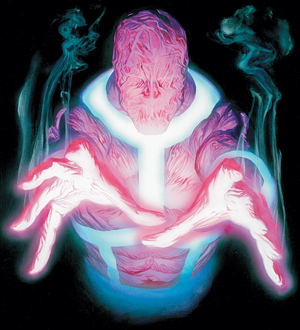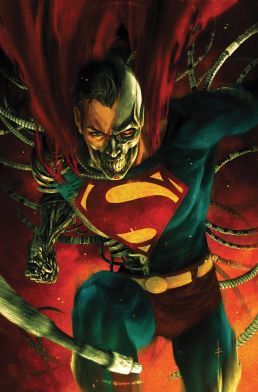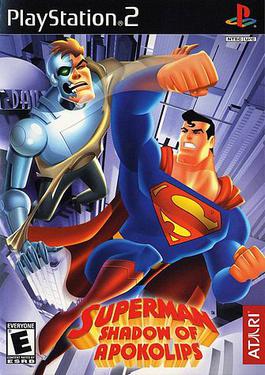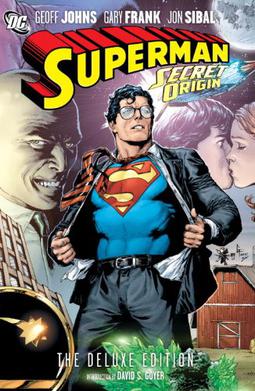
Alexander Joseph "Lex" Luthor is a supervillain appearing in American comic books published by DC Comics. The character was created by Jerry Siegel and Joe Shuster. Lex Luthor originally appeared in Action Comics #23. He has since endured as the archenemy of the superhero Superman.

The Legion of Doom is a group of supervillains who originated in Challenge of the Superfriends, an animated series from Hanna-Barbera based on DC Comics' Justice League. The Legion of Doom has since been incorporated into the main DC Universe, appearing in comics, as well as further animated and live-action adaptations, and also video games.

Bizarro is a supervillain or anti-hero appearing in American comic books published by DC Comics. The character was created by writer Otto Binder and artist George Papp as a "mirror image" of Superman, and first appeared in Superboy #68 (1958). Debuting in the Silver Age of Comic Books, the character has often been portrayed as an antagonist to Superman, though on occasion he also takes on an antihero role.

Brainiac is a supervillain appearing in American comic books published by DC Comics. The character was created by writer Otto Binder and artist Al Plastino, and debuted in Action Comics #242. He has since endured as one of Superman and the Justice League's greatest enemies. The character's name is a portmanteau of the words brain and maniac.

Superman: The New Superman Adventures, commonly referred to as Superman 64, is an action-adventure video game developed and published by Titus Interactive for the Nintendo 64 and based on the television series Superman: The Animated Series. Released in North America on May 29, 1999, and in Europe on July 23, it is the first 3D Superman game.

Imperiex is a supervillain appearing in comic books published by DC Comics. He was initially introduced as an adversary to the superhero Superman, before becoming a main antagonist for the crossover "Our Worlds at War".

Metallo is a supervillain appearing in American comic books published by DC Comics, commonly as an adversary of Superman. He is usually depicted as a cyborg with a kryptonite power source in his heart, which he uses as a weapon against Superman. In 2009, Metallo was ranked as IGN's 52nd-greatest comic book villain of all time.

Mongul is a supervillain appearing in comic books published by DC Comics. Writer Len Wein and artist Jim Starlin created the first version of the character, who debuted in DC Comics Presents #27. Jerry Ordway created the second version, who first appeared in The Adventures of Superman #454 as the lord of Warworld. He was later embellished by Peter Tomasi and Scot Eaton in Showcase '95, #8. He is based on the Mongol Empire's founder Genghis Khan and his successors, hence his name. The character was given an origin story in Green Lantern #23.2 by his co-creator Jim Starlin and artist Howard Porter as homage to the writers who participated in developing the character.

Parasite is the name of several supervillains appearing in American comic books published by DC Comics. Each iteration of the character has the ability to temporarily absorb the life force, attributes, memories, and superpowers of anyone through physical touch. The most well-known and recurring incarnation is Rudy Jones, who has become one of Superman's most enduring enemies and belongs to the collective of adversaries that make up his rogues gallery. In 2009, Parasite was ranked as IGN's 61st Greatest Comic Book Villain of All Time.

"Whatever Happened to the Man of Tomorrow?" is a 1986 American comic book story published by DC Comics, featuring the superhero Superman. Written by British author Alan Moore with help from long-time Superman editor Julius Schwartz, the story was published in two parts, beginning in Superman #423 and ending in Action Comics #583, both published in September 1986. The story was drawn by long-time artist Curt Swan in one of his final major contributions to the Superman titles and was inked by George Pérez in the issue of Superman and Kurt Schaffenberger in the issue of Action Comics. The story was an imaginary story which told the final tale of the Silver Age Superman and his long history, which was being rebooted following the events of Crisis on Infinite Earths, before his modern introduction in the John Byrne series, The Man of Steel.

Henry "Hank" Henshaw is a supervillain appearing in American comic books published by DC Comics, and normally goes by the name Cyborg Superman. Created by writer-artist Dan Jurgens, the character originally appeared primarily as an enemy of Superman, however in recent years he has also been an enemy of the Green Lantern Corps.
The Superman Revenge Squad is the name of two fictional organizations in the DC Comics universe. As their name suggests, it is a group of Superman villains who banded together to defeat the Man of Steel.

Superman Returns is a video game based on the 2006 movie of the same name. It was developed by EA Tiburon and co-published by Electronic Arts and Warner Bros. Interactive Entertainment in conjunction with DC Comics.

Superman: Shadow of Apokolips is a video game that was released in 2002 for the PlayStation 2 and GameCube consoles. It was developed by Infogrames Sheffield House, published by Infogrames under the Atari brand name, and released in conjunction with Warner Bros. Interactive Entertainment and DC Comics. It is based on the television series Superman: The Animated Series.

Superman: Secret Origin is a six-issue monthly American comic book limited series published by DC Comics. The series was written by Geoff Johns and illustrated by Gary Frank, featuring the superhero Superman. The story featured the "definitive" origin of Superman for the modern, post-Infinite Crisis DC Universe continuity, starting with Clark Kent in his pre-teens as Superboy. Within the series he goes on to meet a young Lex Luthor and the Legion of Super-Heroes in Smallville, Kansas, and soon heads to Metropolis where a young adult Clark debuts as Superman.

"Superman: Doomed" is a Superman crossover story arc published by DC Comics starting in May 2014. The series is co-written by Greg Pak, Charles Soule and Scott Lobdell, with artwork by Ken Lashley, Aaron Kuder, and Tony Daniel.

Lego Batman 3: Beyond Gotham is a Lego-themed action-adventure platform video game developed by Traveller's Tales and published by Warner Bros. Interactive Entertainment that was released in 2014. It is the third installment in the Lego Batman video game series and a sequel to Lego Batman: The Videogame and Lego Batman 2: DC Super Heroes. Similarly to its predecessor, the game features voice acting and semi-open world environments, and focuses on a large cast of characters from the entire DC Universe rather than just Batman and Robin. In the game's story, Brainiac attacks the Earth, intending to shrink the planet and add it to his collection, which forces the Justice League and the Legion of Doom to form an unlikely alliance to stop him.
"Warworld Saga" is a Superman crossover story arc published by DC Comics in March 2021. The series is co-written by Phillip Kennedy Johnson and Grant Morrison with artwork by Sami Basri, Adriana Melo, and Miguel Mendoca.

Superman '78 is a superhero comic book limited series published by DC Comics. It is set in the continuity of Alexander Salkind's Superman film series which starred Christopher Reeve as the title character. Robert Venditti, who serves as the writer, revealed that he was working on a follow-up miniseries. A second series titled Superman '78: The Metal Curtain was announced by DC Comics on August 17, 2023. The first issue of the new series was released on November 7, 2023.
"House of Brainiac" is a Superman crossover story arc published by DC Comics in April 2024. The series is co-written by Joshua Williamson with artwork by Rafael Sandoval, Rico Ossio, and Edwin Galmon.
















